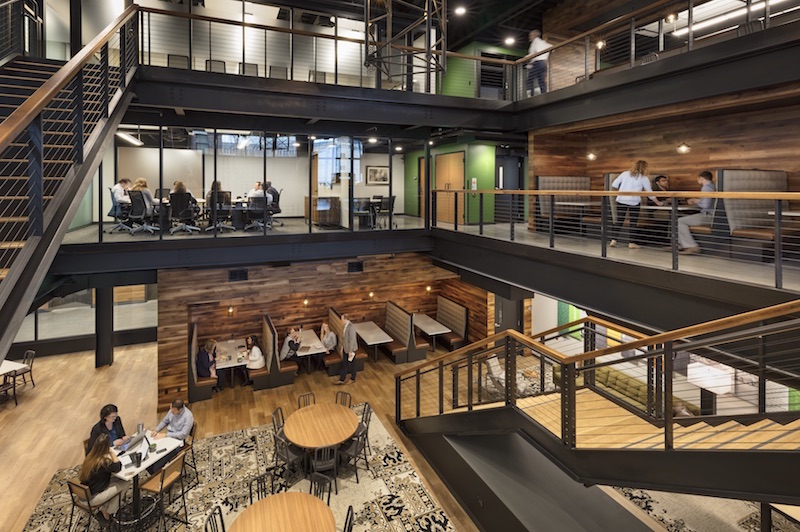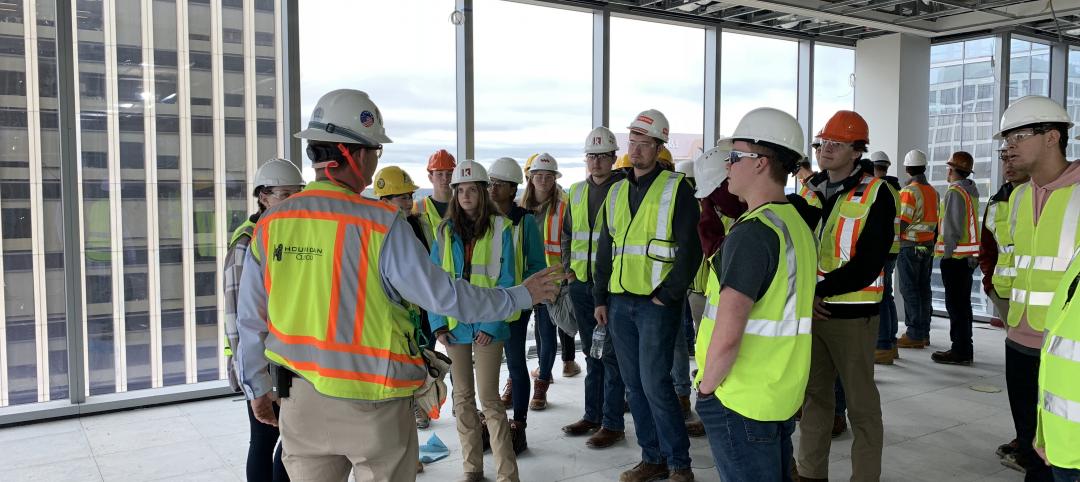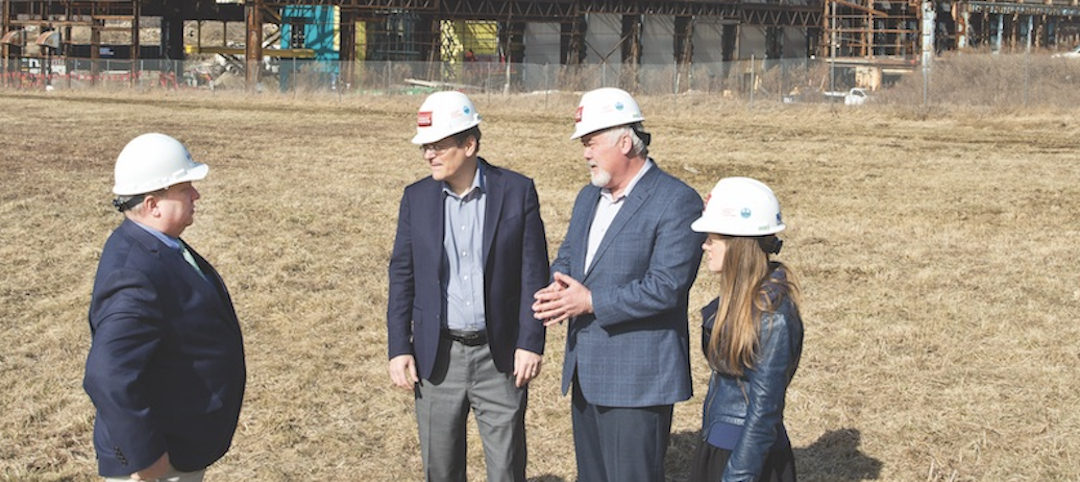The developer Sterling Bay has proposed adding a combined 1.7 million sf of office space within Chicago’s West Loop by replacing several surface parking lots with three office towers ranging from 19 to 21 stories, along with a nine-story building with retail and an eight-screen movie theater.
These buildings, whose proposals went before the Chicago Plan Commission for approval in February, would be located in the Fulton Market neighborhood, a former meatpacking district that has become one of the Windy City’s hottest real estate submarkets. More than three million sf of office space are under construction or proposed for Fulton Market, along with 3,500 residential units scheduled for completion by the end of 2019.
That neighborhood’s new office space will likely become a magnet for expansion-minded tech companies, if recent history is any barometer. Last November, Sterling Bay opened Fulton West, a nine-story, 290,000-sf office building with ground-floor retail. Its tenants include Uber, Glassdoor (a company-review website for jobseekers), Drive Automation (whose technology helps transact auto sales via a mobile app), and Interactive Health (which provides flexible wellness solutions).
 Ryan Companies’ headquarters in Minneapolis, Minn., features a large open area where employees in different departments work as teams and individually at sit-stand workstations. Ryan’s Architecture and Engineering group designed the office space, which includes a vintage delivery truck, an interactive board highlighting the company’s history, and a scaled mockup of Minneapolis’ downtown buildings. Paul Crosby, courtesy Ryan Companies.
Ryan Companies’ headquarters in Minneapolis, Minn., features a large open area where employees in different departments work as teams and individually at sit-stand workstations. Ryan’s Architecture and Engineering group designed the office space, which includes a vintage delivery truck, an interactive board highlighting the company’s history, and a scaled mockup of Minneapolis’ downtown buildings. Paul Crosby, courtesy Ryan Companies.
Tech companies are the most voracious consumers of office real estate in the U.S., and they are expanding. CBRE’s 2018 Real Estate Outlook estimates that the tech sector—which is increasing at about twice the rate of overall job growth—has been responsible for nearly one-fifth of the major office leasing activity in recent years, and will likely be a primary driver this year.
In its latest Tech Office Trends Report, JLL lists tech companies that, through the third quarter of 2017, had added significantly to their leased office space, including Facebook (436,000 sf), Lyft (91,000 sf), Infosys (60,000 sf), and Yelp (54,000 sf). “It doesn’t seem to be slowing down, either,” observes Julia Georgules, JLL’s Senior Vice President and Director of Research.
Apple is planning to build a new campus as part of its larger strategy to invest more than $30 billion in capital expenditures over the next five years and create more than 20,000 new jobs. And the recent beauty contest that pitted 238 cities in North America vying to land Amazon’s new headquarters—which expects to hire up to 50,000 employees and have a $5 billion CAPEX over the next 10 to 15 years—accentuates the importance that metros place on luring tech companies to bolster their economies.
The impact of tech company expansion on the office sector is palpable across the country, no more so than in Midtown Atlanta, where nearly two million sf of office space are under construction. Seventeen major corporations have innovation centers in Midtown Atlanta, spurred by the presence of Georgia Tech, which has one of the nation’s top graduate engineering programs. Cities whose universities tout strong STEM curricula—such as Baltimore and Philadelphia—are often where tech hubs have coalesced. But this trend now seems boundless.
“It’s an economic revolution, a complete shift in our economy toward innovation, technology, mobility, and agility,” JLL stated in its report. “The proof is in the industry’s permeation into markets across the country, not just major tech hubs.”
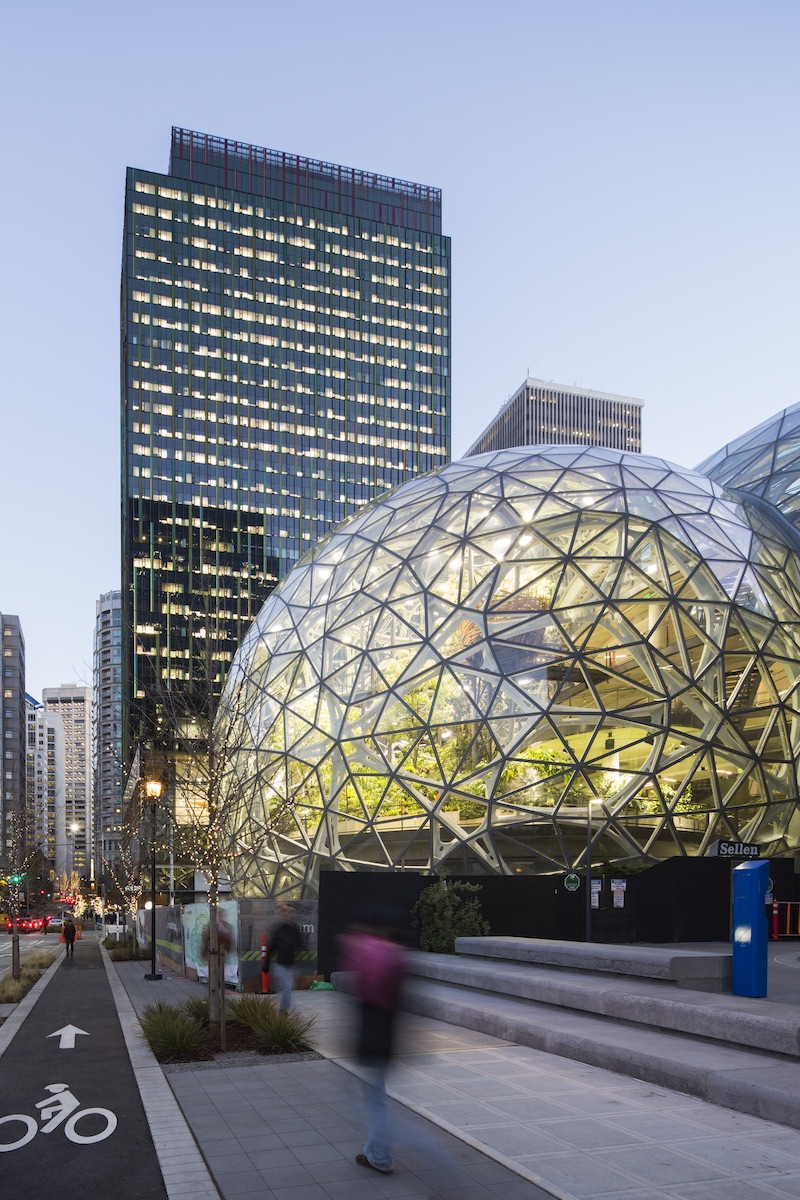 Employers like Amazon are reinventing workplace standards to meet employee demand for more amenity-focused, flexible, and tech-driven environments. Its Seattle HQ, designed by NBBJ, incorporates a unique respite space: glass-enclosed spheres housing plants from around the world. ©NBBJ/Sean Airhart.
Employers like Amazon are reinventing workplace standards to meet employee demand for more amenity-focused, flexible, and tech-driven environments. Its Seattle HQ, designed by NBBJ, incorporates a unique respite space: glass-enclosed spheres housing plants from around the world. ©NBBJ/Sean Airhart.
‘Tech is everywhere’
That permeation is evident in the design of offices in general, as businesses in most every sector—even straitlaced legal and financial services firms—now want their workplaces to present a look and feel that’s collaborative and Millennial friendly. Jacqueline Dompe, Northwest region Director of JLL’s Project and Development Services Group, observes, too, that more businesses accept co-working as a necessary part of how their offices must function.
“Tech is everywhere,” says Lance Leighton, Co-founder of TechOfficeSpaces.com, an online network for tech and creative workspaces. He’s not exaggerating, either: 86% of respondents to CRBE’s 2017 Americas Occupier Survey said they were either reinventing or adapting workplace standards to meet employee demand for more amenity-focused,
flexible, and technology driven environments.
These shifts are manifesting themselves in unexpected places, including the construction arena.
Last summer, the supplier Western Window Systems moved into its new 170,000-sf headquarters and assembly plant, located in an industrial park near Phoenix’s airport. That building includes a two-story office whose open floor plan features wall murals, foosball and pool tables, shuffleboard, and a putting green. Every Friday after 3 p.m. there’s a happy hour where employees choose the food and games.
 ©NBBJ/Sean Airhart.
©NBBJ/Sean Airhart.
Western Window’s office, designed by Ware Malcomb and built by Layton Construction, practically shouts “teamwork,” with conference and “huddle” rooms scattered throughout, decorated to convey various themes.
Last September, Skender Construction moved its headquarters and 105 employees into 38,000 sf in Fulton West, in Chicago. Skender went from having multiple private offices and three conference rooms in its old digs to zero individual offices and 18 conference and breakout spaces in the new space, all on one floor.
“Since the move, it’s been working great, and we’ve had more collaboration than we ever thought possible,” says Clay Edwards, a Vice President at Skender.
About a year ago, Ryan Companies moved its headquarters into 65,000 sf on the first two floors of the new Millwright Building in Minneapolis, Minn., where 300 of its 1,200 employees now work. The design of the building, done by Ryan’s architecture and engineering group, “needed to be authentic and reinforce our brand,” says Josh Ekstrand, AIA, NCARB, the company’s Director of Design. Its precast brick exterior gives the appearance of being weathered.
Inside, a building-length mezzanine overlooks an open floor plan that organizes various departments into partitioned sections, each with its own collaborative area and separate sit-stand workstations. Amenities include a dining area, access to nearby light rail service, and an indoor skyway that connects the entire downtown.
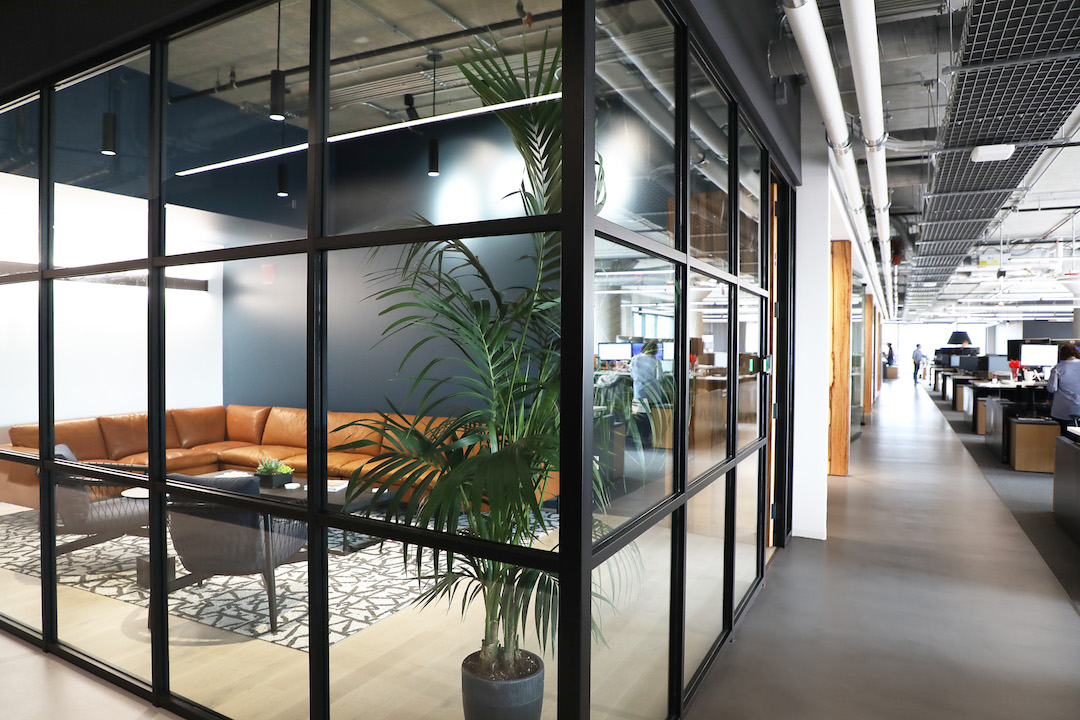 As part of its move to Sterling Bay’s Fulton West building in Chicago, Skender Construction ditched private offices for a modern, open-plan environment, with zero individual offices and 18 conference and breakout spaces across 38,000 sf. Photo: Skender Construction.
As part of its move to Sterling Bay’s Fulton West building in Chicago, Skender Construction ditched private offices for a modern, open-plan environment, with zero individual offices and 18 conference and breakout spaces across 38,000 sf. Photo: Skender Construction.
Designing for future changes
Not everyone thinks all of this genuflection to the tech gods is a good idea. The Atlantic, for one, recently questioned the wisdom of cities and states “forfeiting enormous amounts of tax revenue” to lure tech companies with tax breaks and subsidies to build new facilities, especially when Corporate America has “a long history of reneging on promised jobs and development,” wrote Brian Alexander, the article’s author.
Tech companies have also changed the dynamics for office space supply and demand. While some tech companies have shown a willingness to consider smaller markets for growth, like Charlotte, Austin, Denver, Dallas, and Phoenix, the tech sector still prefers large metros like New York, Chicago, San Francisco, and Seattle that have ample bases of highly educated and qualified employees. “Clustering is very important for the concentration of talent,” says Georgules.
Consequently, businesses that don’t have the tech giants’ deep pockets could be priced out of urban job centers, and find themselves looking for space in the suburbs, where it’s tougher to attract younger workers who prefer the amenities of city living.
Despite these caveats, the “tech” office is here to stay—for a while at least. What businesses value most about this office evolution, says JLL’s Georgules, is how it has engendered “random encounters” among employees that can lead to inspiration. And because tech-like offices minimize private office count in favor of common areas, hard costs and materials are, on average, 21% lower than for traditional offices, estimates JLL.
As a hedge against shifting tides, some developers are trying to “future proof” their office buildings. The Wall Street Journal recently reported how Gensler had designed the new headquarters in Cincinnati for 84.51º, a data analytics firm, with three floors of above-ground parking that can be converted to office space if driverless cars that wouldn’t require parking catch on.
That kind of flexibility, says Leighton, will be much sought after by office tenants, tech or not, going forward.
Related Stories
Women in Design+Construction | Jan 25, 2024
40 Under 40 Class of 2023 winner Kimberly Dowdell inaugurated as AIA 2024 President
The American Institute of Architects (AIA) has announced the inauguration of Kimberly Dowdell, AIA, NOMAC, NCARB, LEED AP BD+C, Principal and Director of Strategic Relationships at HOK and BD+C 40 Under 40 superstar, as its 100th president.
AEC Innovators | Mar 3, 2023
Meet BD+C's 2023 AEC Innovators
More than ever, AEC firms and their suppliers are wedding innovation with corporate responsibility. How they are addressing climate change usually gets the headlines. But as the following articles in our AEC Innovators package chronicle, companies are attempting to make an impact as well on the integrity of their supply chains, the reduction of construction waste, and answering calls for more affordable housing and homeless shelters. As often as not, these companies are partnering with municipalities and nonprofit interest groups to help guide their production.
AEC Innovators | Feb 28, 2023
Meet the 'urban miner' who is rethinking how we deconstruct and reuse buildings
New Horizon Urban Mining, a demolition firm in the Netherlands, has hitched its business model to construction materials recycling. It's plan: deconstruct buildings and infrastructure and sell the building products for reuse in new construction. New Horizon and its Founder Michel Baars have been named 2023 AEC Innovators by Building Design+Construction editors.
40 Under 40 | Oct 19, 2022
Meet the 40 Under 40 class of 2022
Each year, the editors of Building Design+Construction honor 40 architects engineers, contractors, and real estate developers as BD+C 40 Under 40 awards winners. These AEC professionals are recognized for their career achievements, passion for the AEC profession, involvement with AEC industry organizations, and service to their communities.
Movers+Shapers | Nov 7, 2021
Passage of $1.2 trillion infrastructure bill expected to spur stronger construction activity
AEC firms see federal investment as historic
Movers+Shapers | Apr 30, 2020
College programs help prepare students for careers in the construction industry
Universities with AEC programs hone their curricula and research to prepare students to hit the ground running in the construction industry.
Movers+Shapers | Apr 21, 2020
Management Training: AEC firms bring students into the real world
Students benefit substantively from internships offered by AEC firms.
Movers+Shapers | Apr 17, 2020
Meet the ‘AEC outsiders’ who are helping to push the industry into the new decade
AEC professionals have enough on their plates without becoming specialists in a new skill outside of their wheelhouse.
Movers+Shapers | Apr 15, 2020
Buildings as "open source platforms"
NBBJ’s year-old Design Performance Group helps building teams make smarter choices earlier.
Movers+Shapers | Apr 23, 2019
Steely resolve: Carnegie Mellon University fuels Pittsburgh's post-industrial reinvention
After the steel industry started collapsing in the late 1970s, Pittsburgh has been reinventing itself as a science, medical, and academic hub.


